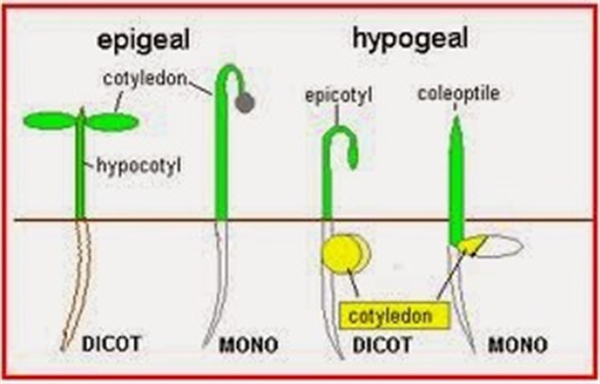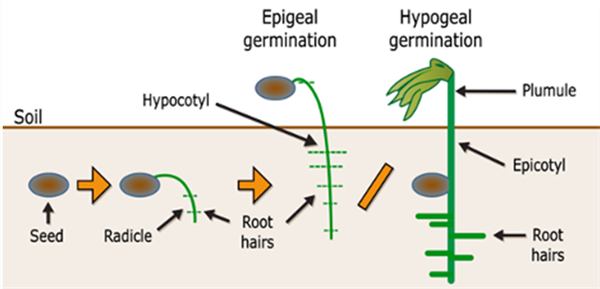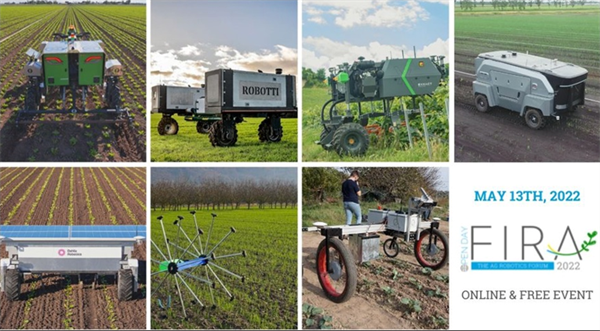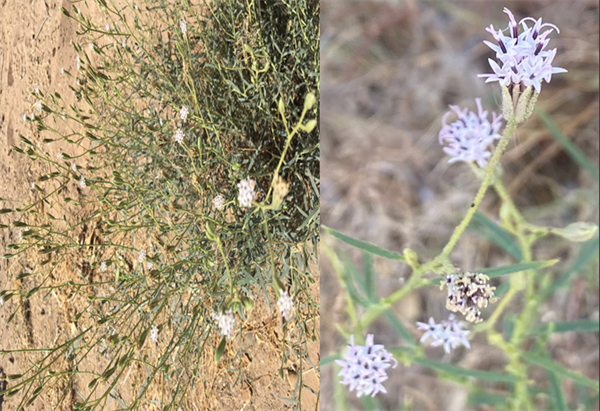
With the planting of every crop there is a time of anticipation as we wait and watch for germination, seedling emergence, and the development of a good stand of plants to start the crop season. Successful seedling establishment is the first critical step for the production of any crop and it determines the foundation for either the success or failure of the future harvest. So, it is worthy to review some fundamentals associated with the process of seed germination and seedling establishment.
Most crops produced worldwide begin with the planting of a seed and management to sufficiently establish a satisfactory population of new plants in the field. Good seed germination and establishment is an essential and critical first step in the production of a good crop. Most crop seeds are desiccation tolerant while dormant and as a result can be stored and transported while preserving their ability to grow. Seeds carry the full genetic complement of the crop and serve as the genetic delivery mechanism for a crop production system. Farmers require seeds that will provide for a reliable and successful establishment of a crop.
An interesting aspect of seed germination and establishment is that seeds generally represent the condition of highest degree of resistance to extreme environmental conditions, while seedlings are most sucseptible. Viable seeds are dormant living organisms that contain living, embryonic tissue that is essential for germination. All fully developed seeds contain an embryo and a reserve supply of carbohydrates and nutrients to carryout germination and establishment and the full “package” is contained within a seed coat.
Seeds are stimulated to “wake up” and start the germination process when soil moisture and temperature conditions are appropriate for them to grow. The three cardinal points of vital activity for germination are: 1) a minimum temperature, below which no activity occurs, 2) an optimum temperature at which the highest germination occurs, and 3) a maximum temperature above which no germination takes place.
All seeds need correct moisture and temperature environments (Table 1) to initiate internal biochemical processes associated with the initation of germination. Soil-water content generally needs to be at least approximately 50–75% of field capacity. A fine-textured seedbed and good seed-to-soil contact are very imporant for optimal germination.
Good soil aeration that facilites good gas exchange between the germinating embryo and the soil environment is very important. Seeds respire just like any other living organism. Germinating seeds need oxygen and they produce carbon dioxide (CO2). The CO2 needs to be able to diffuse away from the seed and if the soil is compacted or saturated, aeration is inhibited and the CO2 respiration will not be able to dissipate to the atmosphere, and as a result the seeds can suffocate in the soil.
There are three major steps in the initial process of seed germination. These include: 1) imbition, 2) interim or lag phase, and 3) radicle and root emergence.
In the imbibition process seeds rapidly absorb water through the hilum of the seed and the seed coat will then swell and soften.
In the interim or lag phase the seeds internal biochemical and physiological system goes into action. Cells begin respire with this physiological activity and the seed begins to metaboloize its storehouse of energy and nutrient reserves to manufacture proteins other essential metabolites.
The radicle is the very first element of the rooting system that is developed and it is the first thing to emerge from the seed. In the field, we often refer to the radicle as the first “stinger” root that is developed. In the field, it is good to dig into the seedbed and examine early seedling development and look for healthy radicles, with clean, white, and turgid tissue.
In the process of radicle and root emergence, the cells of these tissues start to elongate and divide, the seed continues to imbibe water, and then it begins to extend out and away from the seed into the soil. These early root tissues, specifically the fresh root hairs become quickly capable of water and nutrient uptake. The young root tissues are very sensitive to the soil environment, particularly the soil solution. It is in this stage for example when seedlings are often very sensitive to salinity in the soil solution and disease infections.
When the radicle begins absorbing water from the soil solution, the seedling gains the capacity to extend a shoot from the seed towards the soil surface for emergence. In dicotyledonous (dicot) plants (generally referred to as broadleaf plants) the two seed leaves are extended above the soil for emergence. The section below the shoot and the cotyledons is referred to as the “hypocotyl” and the section of the shoot above the cotyledons is the “epicotyl”, Figure 1.
There are two basic methods of emergence for plants. In most dicot plants, a hook is formed in the section of shoot below the cotyledons which serves to pull the cotyledons and the growing point of the new plant up through the soil. Upon the reaching the soil surface, the hook will straighten and pull the cotyledons (seed leaves) and shoot tip into the air. For the farmer or agronomist in the field, that is a good sight to see. This method of emergence is called “epigeous or epigeal germination”. Examples of epigeal germination are cotton, sunflower, castor, and bean (common bean), Figure 1.
In other plants a process of “hypogeous or hypogeal germination” takes place. In hypogeous germination, the hypocotyl remains short and the cotyledons do not emerge from the seed and remain underground. Instead, the radicle and epicotyl axis will elongate and extend out of the seed coat. The epicotyl grows up through the soil and emerges above the soil surface and forms a epicotyl or “plumule” for the first leaf, Figure 2a and b.
All monocotyledons plants such as maize, rice, wheat, and coconut show hypogeal germination. It is also interesting to note that some dicot plants show hypogeal germination such as groundnut, gram, and peas.
In general, plants with epigeal germination, most dicot or broadleaf plants, are more sensitive to soil crusting and environmental inhibitions to emergence. So it is good to know what type of germination and emergence characteristics are natural for a given crop species and to track seedling development in the field accordingly.
As we begin any new crop season in the field and plant the seeds, it is good to review the basic process of seed germination and establishment. We can easily take all of this for granted until something goes wrong and we have problems in the field with emergence. After planting, it is good to monitor in-field seedling conditions and progression of growth and development, both above and below ground, and provide good management that supports the young plants as they get established and start their growing cycle.
Table 1. Soil temperature (oF) for crop germination. Adapted from Kemble and Musgrove (2006).
|
Crop |
Minimum oF |
Optimal Range oF |
Optimum oF |
Maximum oF |
|
Beet |
40 |
50–85 |
85 |
85 |
|
Cabbage |
40 |
45–95 |
85 |
100 |
|
Cauliflower |
40 |
45–85 |
80 |
100 |
|
Celery |
40 |
60–70 |
70 |
85 |
|
Chard |
40 |
50–85 |
85 |
95 |
|
Cucumber |
60 |
60–95 |
95 |
105 |
|
Eggplant |
60 |
75–90 |
85 |
95 |
|
Lettuce |
35 |
40–80 |
75 |
85 |
|
Melons |
60 |
75–95 |
90 |
100 |
|
Onion |
35 |
50–95 |
75 |
95 |
|
Parsley |
40 |
50–85 |
75 |
90 |
|
Pepper |
60 |
65–95 |
85 |
95 |
|
Pumpkin |
60 |
70–90 |
90 |
100 |
|
Spinach |
35 |
45–75 |
70 |
85 |
|
Squash |
60 |
70–95 |
95 |
100 |
|
Tomato |
50 |
70–95 |
85 |
95 |

Figure 1. Seed germination and plant establishment for a plant with epigeal
germination and emergence, which is common with most dicot or broadleaf
plants.

Figure 2a. Examples and comparison of epigeal and hypogeal germination.

Figure 2b. Examples and comparison of epigeal and hypogeal germination.
Frost and freeze damage affect countless fruit and vegetable growers leading to yield losses and occasionally the loss of the entire crop. Frost damage occurs when the temperature briefly dips below freezing (32°F).With a frost, the water within plant tissue may or may not actually freeze, depending on other conditions. A frost becomes a freeze event when ice forms within and between the cell walls of plant tissue. When this occurs, water expands and can burst cell walls. Symptoms of frost damage on vegetables include brown or blackening of plant tissues, dropping of leaves and flowers, translucent limp leaves, and cracking of the fruit. Symptoms are usually vegetable specific and vary depending on the hardiness of the crop and lowest temperature reached. A lot of times frost injury is followed by secondary infection by bacteria or opportunist fungi confusing with plant disease.
Most susceptible to frost and freezing injury: Asparagus, snap beans, Cucumbers, eggplant, lemons, lettuce, limes, okra, peppers, sweet potato
Moderately susceptible to frost and freezing injury: Broccoli, Carrots, Cauliflower, Celery, Grapefruit, Grapes, Oranges, Parsley, Radish, Spinach, Squash
Least susceptible to frost and freezing injury: Brussels sprouts, Cabbage, Dates, Kale, Kohlrabi, Parsnips, Turnips, Beets
More information:
Interested in staying up to date on the latest international robotic ag technologies? FIRA (International Forum for Agricultural Robotics) held an “Open Day” May 13th and posted recorded presentations on their website. In addition to technical panel discussions with industry experts, the event included live field demos of weeding, scouting and general farming robots. The FIRA Connect website also has replays of presentations given at the 2021 FIRA Conference held last December. In total, there are thirty short presentations and field demos of ag robots freely available. About 1/3rd of the presentations/demos are weeding machines from Europe that utilize various methods for in-row weed removal – lasers, precision spot sprayers, concentrated light beams, and mechanical devices including knife blades, rotating heads, and weed pulling mechanisms. The site also provides links to a “Robot Wall” and a “R&D Wall” where companies have posted information about their commercially available and in-development ag robots. It is a quality website and worth checking out to learn more about the latest automated agricultural technology innovations being developed around the world.
To connect to the FIRA website, click here


Wellton, AZ

Yuma, AZ
Palafoxia arida is a plant from the family Asteraceae also called the Sunflower family. It is native to the Desert regions of California and the SW United States in AZ, NV, CA, UT, Baja California and Sonora. It is an annual weed that grows erect and has rough hairs on the leaves, which are grayish green and narrow or linear. This plant can grow up to 6 ft has a main tap root. The flower heads are about 2-3 cm long with several (up to 40) tubular five lobed florets white to light pink color. Its habitat includes sandy plains, mesas, washes, dunes.
We found this weed abundantly in our Yuma County Survey. The highest populations were found at the Yuma Mesa around fields. Also found in newly established alfalfa fields. Despite the fact that it prefers sandy soils we also detected Palafoxia all across the Yuma County from the Texas Hill area Wellton, Dome Valley to the San Luis Arizona border. Please see Yuma County map below.
The Arizona Vegetable IPM Team will be checking to see if this weed is a possible host for INSV (Inpatiens Necrotic Spot Virus).
Results of pheromone and sticky trap catches can be viewed here.
Corn earworm: CEW moth counts remain at low levels in all areas, well below average for this time of year.
Beet armyworm: Trap increased areawide; above average compared to previous years.
Cabbage looper: Cabbage looper counts decreased in all areas; below average for this time of season.
Diamondback moth: DBM moth counts decreased in most areas. About average for this time of the year.
Whitefly: Adult movement beginning at low levels, average for early spring.
Thrips: Thrips adult counts reached their peak for the season. Above average compared with previous years.
Aphids: Aphid movement decreased in all areas; below average for late-March.
Leafminers: Adults remain low in most locations, below average for March.